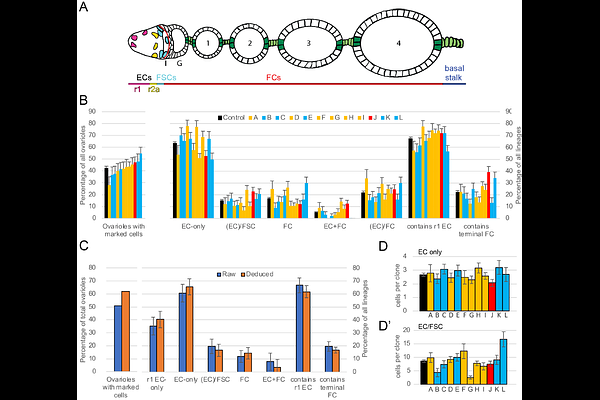Regulation of somatic stem cell and niche precursor fates and proliferation of by Wnt, JAK-STAT, Hedgehog and Hippo/Yorkie pathways during Drosophila pupal ovary development resembles the signaling framework organizing adult stem cell behavior.

Regulation of somatic stem cell and niche precursor fates and proliferation of by Wnt, JAK-STAT, Hedgehog and Hippo/Yorkie pathways during Drosophila pupal ovary development resembles the signaling framework organizing adult stem cell behavior.
Misner, R.; Reilein, A.; Kalderon, D.
AbstractFollicle Stem Cells (FSCs) in the germarium of a Drosophila melanogaster ovary are maintained through independent regulation of division and differentiation. Adult FSCs can become proliferative Follicle Cells (FCs) to the posterior, or quiescent Escort Cells (ECs) to the anterior. Graded extracellular Hedgehog (Hh) and Wnt signals emanate from cells anterior to FSCs (Cap Cells and ECs) to guide these behaviors together with an inverse JAK-STAT pathway stimulated by ligand from a more posterior source (polar FCs). Here we used lineage analyses to investigate the role of those signals in the development of ECs, FSCs and FCs from a common set of precursors during pupation. Previous studies found that the most anterior precursors divide slowest, with quiescence spreading to all future ECs from the anterior, FSCs are specified simply by their location at eclosion, and the first FCs derive from a group of cells that accumulates posterior to the developing germline over the first 48h of pupation. We now show that the latter cells derive from migration of precursors out of the developing germarium. We also found that Wnt pathway activity favored conversion of precursors to more anterior adult derivatives, while JAK-STAT pathway activity favored posterior outcomes. Wnt pathway activity increased over the first 48h and maintained a graded pattern throughout pupation, terminating at the anterior extent of FC specification, commensurate with Wnt pathway activity continuously opposing FC formation. JAK-STAT pathway activity was consistently lowest in anterior cells, indicating a posterior source early in pupation prior to formation of the first polar FCs. Precursor division was promoted by JAK-STAT signaling and also by Hh signaling, acting through transcriptional induction of yorkie. Faster division favored a precursor becoming an FSC, as seen for FSC lineage maintenance in adults.